By Jennifer Barnable, senior digital writer
When my first aid certification expired during the pandemic, I knew it was time to renew. Typically, I’d be keen to refresh my skills and knowledge – after all, being able to help in an emergency is a valuable skill to have.
Still, I hesitated.
Unlike the last time I’d certified, I now live with reduced mobility and was feeling less confident about training this time around. I was concerned about successfully completing the course – particularly the cardiopulmonary resuscitation (CPR) portion. Above all, I wanted to feel sure that I was ready to respond if I happened upon someone in need.
Nonetheless, I enrolled in a blended online and in-class first aid course through Life Shield, a Canadian Red Cross Training Partner in Nova Scotia. As I worked through the online portion of the course curriculum, I noticed the material mentioned adaptations for certain first aid skills.
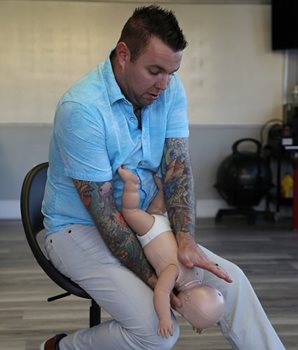 |
|
Kyle Mohler of LifeShield First Aid demonstrates seated first aid technique for infant choking. Photo credit: Jennifer Barnable
|
Arriving at the training facility for the in-class portion, I spoke with the instructor, Larry, privately about my needs. He confidently assured me that the full-day session we were about to begin would include learner accommodations.
I was relieved, and though still a little apprehensive, I was ready to renew my life-saving skills.
As we set in for an action-packed training day with multiple levels of COVID-19 precautions, I began to reflect more on the importance of adapted first aid training – not only what it meant to me, but what accessibility and inclusion means to an entire community of learners.
To me, making adapted learning options available just makes good sense. More opportunities to complete first aid training mean more people prepared to respond to real-world emergencies.
Including an entire community of learners
More than 5.3 million Canadians of all ages currently live with disability, according to Stats Canada. That’s almost 16% of the country’s population who identify as living with some form of disability that affects quality of life, level of freedom and independence. Globally, over one billion people – one in five – experience disability, as revealed by reports from the World Health Organization and United Nations.
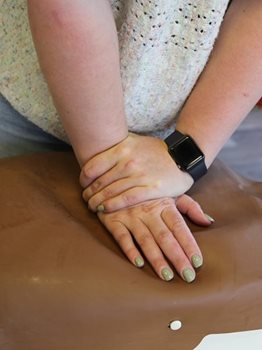 |
|
Adapted CPR chest compression hand positioning for people with arthritis or reduced wrist and hand strength. Photo credit: Jennifer Barnable
|
This reality is an important consideration for first aid program developers and educators who deliver these courses to a diverse range of participants -- participants who bring their own knowledge, skills and lived experience to the classroom. Accessible learning ensures all community members can participate, whether they seek practical knowledge or require a certification for work or community volunteer roles.
First aid learners can include those with mobility disabilities, hearing loss, chronic pain, arthritis, limb differences and cognitive disabilities, to name a few. Additionally, course participants may be living with temporary injuries or conditions that make it difficult to get up and down from the floor during training due to knee, back, hip or arm injuries.
Aging also brings naturally progressive loss of strength and mobility. Reduced hand and shoulder use can impact grip, balance and range of motion that can impact our first aid skills. Adapted first aid training options work here as well.
An inclusive approach to Red Cross first aid training
The Canadian Red Cross strives to offer inclusive and accessible first aid education so that all course participants can learn first aid skills. Interested to learn more, I spoke with some experts in first aid program development and facilitation.
“The need for life-saving knowledge and skills is universal to all communities and people,” explains Joanna Muise, a senior advisor with the Canadian Red Cross First Aid Program. “The act of caring through first aid is part of our values, rooted in our earliest history as a humanitarian organization when Henry Dunant helped wounded soldiers at the Battle of Solferino in 1859.”
She continues, “First aid training should support people and communities in caring for others, and provide individuals with the confidence to recognize and provide care for illnesses and injuries. This includes recognizing responders’ personal limitations and making necessary training adaptations. Instructors have a goal to make the first aid learning experience as accessible as possible by adapting lesson plans and offering accommodations.”
Accommodation examples can include providing a learner with a reading difficulty the option to complete a knowledge evaluation verbally instead of in writing, or offering a table to a learner with a mobility disability to practice CPR skills on a raised surface instead of the floor.
Small adaptations, significant outcome
Back in the Life Shield classroom, we were moving into the CPR portion of the training course. This was the part I’d worried most about and was relieved to learn that there were adaptations to positioning during chest compressions.
With guidance from the instructor and a slight posture change, I was able to complete the series of rhythmic chest compressions, keeping right on target. These small adaptations can deliver significant results – in my case, it meant I could still perform effective CPR to help keep another person alive.
Working on the ground with a partner (both safely gloved and masked), I also learned to rely on my lower body strength more for some skills. By using my knee to gently roll my partner into the recovery position, I could take any strain off my upper body. We learned that this adaptation is ideal when the person you’re helping is larger than you or if you’re experiencing limited mobility and strength at the time you’re responding. Our instructor shared that this movement could also come in handy if you, yourself, were injured in the same accident and were the only person on the scene to respond.
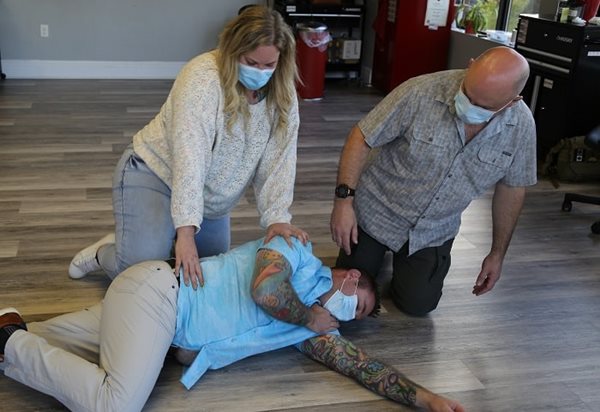
LifeShield instructor Larry Eisenhauer coaches colleague Erin Nauss on a first aid adaptation to the Recovery Position, using the knee to roll a person (Kyle Mohler) into place. Photo credit: Jennifer Barnable
Throughout the day, the instructor subtly checked in with me to support me if needed, while I was able to remain keenly focused on practicing the various skill sequences. Thanks to coaching and a simple adaptation, I was easily able to keep pace with the two-minute, five-cycle CPR rhythm. This redoubled my enthusiasm for the next skills to come.
His discretion also ensured unnecessary attention was not drawn to me, important in ensuring I was not “othered.” This was inclusion done right. Some classmates required slight adaptations as well, for a variety of reasons, with others asked thoughtful questions about assisting people with disabilities in emergency situations.
By supporting my participation and focusing on appropriate adaptations, the instructor created a meaningful and inclusive first aid training experience.
A passion for creating accessible first aid training experiences
Carolyn Hoekstra is a member of the Canadian Council for First Aid Education and long-time Instructor Trainer at Christian Horizons, a Red Cross Training Partner. No stranger to advocating for accessible first aid education, she develops and leads training courses, while also coaching other instructors.
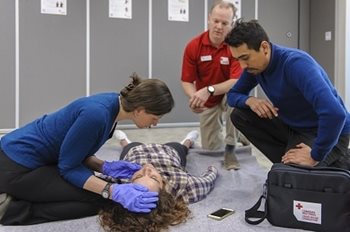
“Through my roles, it became clear to me how important it is to offer accommodations to learners with developmental and learning disabilities,” says Carolyn. “Our main goal as instructors is to make learning accessible and achievable for all people. I noticed, however, that the first aid course content and timelines didn’t meet all participants’ learning needs.”
Carolyn observed that learners with disabilities and those whose first language was not English were among the participants who quickly fell behind, and she was determined to change that experience.
“I recognized that while participants knew and understood the first aid concepts and skills presented in class, the course structure and pace were not accommodating. Many left frustrated and disappointed that they did not achieve Red Cross certification, and I wanted to change this. I began advocating for and developing adapted first aid training techniques.”
The benefits of adapted first aid training
Adapted first aid training can bolster a learner’s confidence and their likelihood to act in a situation requiring emergency response.
“Before we feel ready to act, each of us needs to believe that we have the knowledge and skills to be successful,” Joanna says. “Red Cross first aid curriculums focus on participants’ needs and interests, with a goal of increasing their confidence and understanding of first aid techniques and behaviours. We create a safe, cooperative and supportive classroom environment so that learners can do just that.”
Joanna notes that Red Cross first aid training has also evolved over the years to become more and more inclusive.
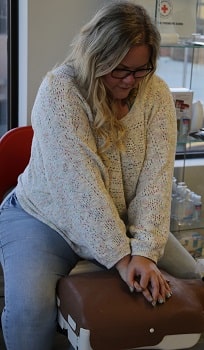 |
|
Erin Nauss, LifeShield instructor, demonstrates adapted CPR chest compressions from a seated position. Photo credit: Jennifer Barnable
|
“For several years, we’ve been making a focused effort to simplify the technical nature of our first aid program content whenever possible,” she says. “In the past, directions for placing someone into the recovery position were unnecessarily complicated and would intimidate learners. Now, we now focus first on why you would want to use the recovery position, and then provide simple guidance for how to accomplish the task confidently.”
Carolyn agrees. “Having facilitated non-certified first aid courses and leading the Canadian Council for First Aid Education to explore strategies for supporting diverse learners, it’s clear that adapted first aid training offers people with disabilities a more equitable learning experience.” She continues, “With specific adaptations, learners are more likely to build important knowledge and skills, have a higher certification rate, and feel a sense of pride and accomplishment in gaining this much-desired skill set.”
Best practices for adapted first aid training
Carolyn’s experience supporting first aid learners with cognitive, developmental, and physical disabilities has helped inform more accessible course delivery. I asked her how outcomes have changed as a result, and if she had any best practices to share.
“Instructors can adapt the course delivery in various ways so that participants can settle in and focus on learning first aid concepts and practicing the skills,” she notes. “Over the years, I’ve put a number of adaptations into practice and have seen participant score levels increase – from barely making the passing grade to scoring within the 85-100% range.”
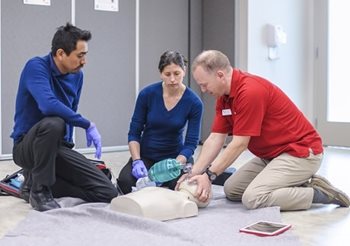
Some best practices for first aid training adaptations include:
- creating consistent lesson plans with clear skills demonstrations
- focusing on technique coaching and a tactile approach
- adapting the pace of exercises
- increasing class discussion and group activities
- creating appropriate and relatable scenarios to solve in practical ways
- providing pictorial cards with words to organize step-by-step techniques
- focusing on hands-on learning through props, manikins and partners
- planning course segments and activities according to learners’ needs (e.g. attention span, mobility requirements)
- presenting shorter content-heavy sessions by dividing the material over a course of days
- eliminating test anxiety by offering shorter tests after each chapter, instead of a large test at the end of a long day
- offering verbal or audio testing options (e.g. instructor reading questions out loud)
- allowing learners to choose from verbal or written test options
- adapting floor work for participants with mobility restrictions by providing the option to practice the skill from a standing, bending or seated position
- making sure to have fun along the way!
First aid education is for everyone
The Canadian Red Cross wants everyone who sees themselves as first aiders to be able to pursue their learning goals, feel confident, and be ready to respond when the need arises.
“Everyone, from individuals to communities, benefits from first aid education,” Joanna notes. “At the Red Cross, we recognize that course participants come to us with different motivations and prior experience. We do our best to provide a variety of learning themes and formats so that all learners can easily see a link between our programs and their current needs – whether their goal is certification or practical knowledge to help loved ones and neighbours.”
Carolyn echoes this sentiment. “Every person has the right to learn first aid skills at a level that is appropriate for them. Since most will be used to respond to emergencies at home, it’s important for everyone to learn life-saving skills. A non-certification First Aid Basics workshop can help prepare people to care for themselves and others in emergency situations. Meanwhile, adapted training options are also there, too, for those requiring Red Cross certification for work or volunteer opportunities in their communities.”

As a Red Cross first aid learner myself, this accessible training experience was a valuable outcome. Despite my initial uncertainty and concerns about my current mobility, I left training with the same assuredness I’d felt when certifying in years past.
While some of the movements I now use have changed, one thing remains the same: I am a first aider. We are as diverse as the communities we come from, sharing a concern for others that motivates us to learn and be ready to respond in times of need.
Whether you require Red Cross first aid certification for professional purposes or simply want to be better prepared for emergency situations, adapted Red Cross first aid training will set you on a sure route to readiness.
The article is for informational purposes only and does not replace first aid training. Find a first aid course near you here. Download the free, interactive Red Cross First Aid App to practice and maintain your life-saving knowledge.
Related Stories: